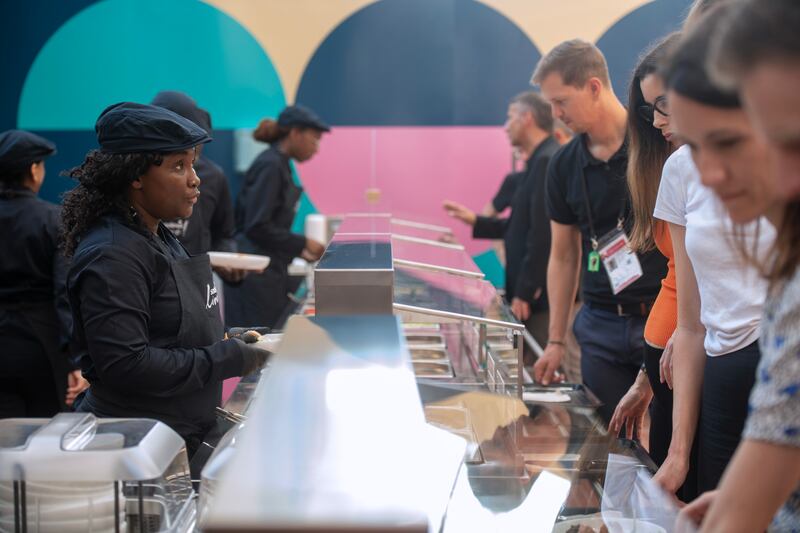The unforgettable moment when a competing athlete first enters the Olympic Village in Paris may be defined not by the complex’s impressive size and sweep, but by a smell: the scent of freshly baked baguettes.
This is by design.
“Every French village has a bakery,” said Guillaume Thomas, who works in communications for the Paris Olympics. “We want people to be able to smell the baguette as they enter.”
A boulangerie set up at the mouth of the village will churn out more than 2,000 baguettes, croissants, pain au chocolat and focaccia daily, and even offer baking classes for athletes seeking respite from the gruelling competition.
READ MORE
For the 15,000 Olympic athletes competing this summer, food is vital for optimising performance. The French would like to sprinkle in some delight.
The centrepiece of the sprawling Olympic Village, once a power plant and then a film studio, is a network of six restaurants that will serve athletes around the clock. Yes, restaurants. Or so the organisers call the places known as dining halls at past Olympics.
“It was out of the question to call it anything else,” said Philipp Würz, the food and beverage manager for the Olympics.
At the end of a of a grand runway lined with flags from every delegation stands the 46,000-square-foot restaurant complex, with towering ceilings and imposing windows overlooking the Seine. But inside, it looks a lot like a college cafeteria. There are cereal dispensers, soda fountains and buffets among red floor tiles and kitschy decorations, like a colourful installation of pipes adorned with graffiti and cartoon eyes.

What a college cafeteria does not have, though, are three chefs of famed French restaurants – Akrame Benallal, Amandine Chaignot and Alexandre Mazzia – who will prepare dishes like coco beans with parsley ice cream and crispy mushroom croquettes.
The staff will wear polos and gavroche caps. There will be cheese plates and French butter. The dishware is French porcelain, to be washed in three colossal dishwashers built for the Games.
In late June, Sodexo Live, the French food-service company overseeing this operation, conducted a tasting for the media of the dizzying array of dishes to be served at the Olympic Village, including green gazpacho (refreshing), saffron risotto (vibrant and creamy), falafel (well spiced but dry) and financiers (a tad too sweet).
[ Ireland’s bright Olympic prospects are good news for sponsors and RTÉOpens in new window ]
But there’s a difficult balance to strike between showcasing the French lifestyle and serving 40,000 meals a day that must cater to countless athletic, cultural and dietary requirements.
Sodexo brought in 20 of its chefs from around the world to ensure cultural sensitivity in the six restaurants. Two of the restaurants are French, two are Asian, one is halal and one is simply called “world”.
Carole Galissant, who works in nutrition at Sodexo Live, co-ordinated with nutritionists from each delegation to ensure specific needs were met. The Koreans wanted kimchi. The Japanese wanted miso. Not all requests could be fulfilled. Several Caribbean nations asked for passion fruit, but sustainability regulations for the Games prohibit importing ingredients by air.
“We are still placing a special focus on the French recipes,” Galissant said. “Blanquette de veau, lemon tart, Paris-Brest.”
Sharon Madigan oversees nutrition for the Irish Olympic team. “These are great opportunities for athletes who may not have a wide palate to try foods that they would not usually have, and like them and enjoy them,” she said.
With one caveat: The Irish need their porridge. “Porridge is something that the French really don’t do very well, or don’t do at all,” she said. “We are bringing oats. Lots of them.”
Madigan said her athletes were excited to socialise in the Olympic Village restaurants, especially after the limited communal dining in Tokyo, during the pandemic. Thankfully, the French are very familiar with the art of gathering.
“Here in France, we talk about conviviality, about eating together, and that is also an element of an athlete’s performance,” said Galissant, the Sodexo nutritionist.
But many athletes may never get to try those dishes.

Olympics 2024: The key events for Irish viewers
“The rule of thumb is to try to stick to what is familiar as much as possible and minimise the new,” said Purity Kamande, a nutritionist for the Kenyan Olympic team. “Because we know that with the new, all these issues could come and affect them.”
With that in mind, she is shipping a package to Paris containing Kenyan comforts like ugali, a carbohydrate-heavy cornmeal, and Kericho Gold tea.
Shawn Hueglin, a senior sports dietitian for the United States Olympic Committee, said the Americans mailed protein shakes, pretzels, popcorn, jerky, energy bars and, of course, peanut butter for their athletes.
Hueglin, who has worked at four Summer Olympics, said the host country will sometimes focus on promoting its cuisine at the expense of meeting athletes’ performance needs. While she appreciated that the dining hall at the 2021 Tokyo Olympics served food from every region of Japan, “they weren’t the best options for athletes to grab before they went to compete,” she said.


Brice Guyart, a two-time gold medallist in fencing who has been consulting with athletes to help fine-tune their experience at the Paris Olympics, said he has always loved that everyone at the Games can eat in one place, no matter the athlete or the nation. At the 2000 Olympics in Sydney, he went to the dining hall at 1am right after winning the gold and befriended Shinichi Shinohara, a Japanese silver medallist in judo.
Guyart had several requests for the Sodexo Live team based on his experiences: Don’t make the plates too big, or athletes will overeat. Keep the temperature moderate, as diners at the Sydney and Athens Olympics had to wear coats in the cafeterias. He also suggested that the chefs make cakes for athletes celebrating birthdays. “It’s the little things,” he said.
Guyart said that along with winning gold in Athens, he fondly remembers the Greek salad at the cafeteria, with fresh cucumbers and tomatoes, and big chunks of briny feta.
“That’s my Proust madeleine,” he said.
Benallal, one of the restaurant chefs cooking at the Village, is hoping he can conjure up some similarly evocative moments for the Paris athletes.
“They for sure have nutritional needs,” he said. “But also maybe sometimes, they can have pleasure.” – This article originally appeared in The New York Times.
2024 The New York Times Company


















